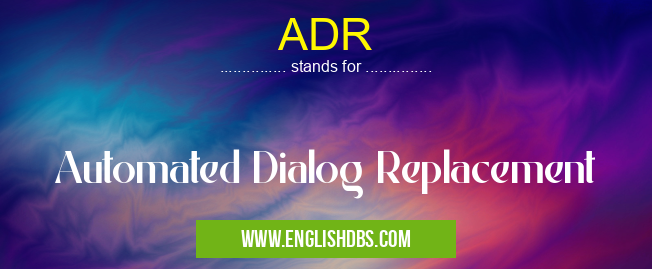What does ADR mean in UNCLASSIFIED
ADR stands for Automated Dialog Replacement and is a term used in the media industry. It's a technique used to improve dialogue quality in post-production editing, also known as "looping". ADR is often used when the sound recorded during production was not of high enough quality due to surrounding noise, or when lines had to be re-recorded at a later date for any reason. ADR allows filmmakers to replace or re-record dialogue with better audio after filming has taken place.

ADR meaning in Unclassified in Miscellaneous
ADR mostly used in an acronym Unclassified in Category Miscellaneous that means Automated Dialog Replacement
Shorthand: ADR,
Full Form: Automated Dialog Replacement
For more information of "Automated Dialog Replacement", see the section below.
Benefits of Using ADR
ADR provides multiple benefits including improved clarity and tone of speech and enabling producers to deliver better audio without spending extra money on additional studio time associated with dubbing/overdubbing original recordings in multi-track form. Additionally, it allows filmmakers more creative freedom in terms of how they want their finished product's soundtrack to sound like.
Essential Questions and Answers on Automated Dialog Replacement in "MISCELLANEOUS»UNFILED"
What is ADR?
Automated Dialog Replacement (ADR) is a technology used in digital media production to replace or supplement existing audio recordings with cleaner, higher-quality, performances. This process generally involves using specialized software and other methods to digitally recreate dialogue from the original performance, while also providing new acoustics and background sounds.
How does ADR work?
ADR works by isolating elements of a recorded performance and creating new versions that improve upon the sound quality. This includes managing volume levels, dynamic range, removing clicks and pops, eliminating microphone bleed, and adding reverb or compression effects. The end result is a more authentic sounding recording that better conveys the intended emotion of the scene or moment.
When is it necessary to use ADR?
It may be necessary to use ADR if the original recording was too noisy or distorted to obtain a satisfactory sound quality for the audio product. Additionally, producers may take advantage of ADR when actors in scenes need to be dubbed with their own voice but were unable to record clean audio at the time of filming due to vocal fatigue or other issues that interfere with sound quality.
Do I need any special equipment for ADR?
Yes - some form of automated dialogue replacement requires specialized hardware such as microphones, mixers, compressors/processors and monitors for producing professionally mixed recordings. Additionally, a practice space which provides soundproofing from external noise sources will also improve overall recording quality.
Can I do my own ADR sessions at home?
Yes - if you have access to all the appropriate equipment for setting up an ADR session then you can certainly produce your own recordings at home without having to hire an outside studio space or production company. However, you should always consult professional engineers or producers if your project requires extensive post-production treatments such as those mentioned previously (i.e., noise reduction & dynamics processing).
What are some tips on doing a successful ADR session?
Here are some tips for ensuring successful results when doing an automated dialog replacement session; 1) Set up your workspace in an acoustically treated environment; 2) Listen critically throughout each take and make sure that no unwanted noises/disturbances are present; 3) Have backups of both audio files & editing software; 4) Use a condenser microphone instead of dynamic mics; 5) Ensure that levels are set correctly & adjust as needed; 6) Run frequent tests with playbacks before committing any changes; 7) Limit takes — too many takes can be counterintuitive! Finally, 8) Respect actors’ vocal career by not pushing them too hard or overworking their delivery.
How long does it take to complete an automated dialog replacement session?
Generally speaking, most simple edits can take anywhere between 30 minutes to 2 hours depending on how many lines need replacing/adding in addition to any post-processing treatments (i.e., EQ matching). More complex projects can take significantly longer as they require more intensive editing work such as noise reduction & various dynamics processing techniques.
Are there any alternatives available for automation dialog replacement?
Yes - if you don't have access to specialized tools and hardware needed for automated dialogue replacement then there are several alternative solutions available such as audio looping programs like Waveform 10 which allow you create natural sounding samples without needing expensive recording equipment.
Is there any room for creativity when using automation dialog replacement software?
Absolutely - even though this type of technology is mainly used for correcting errors within existing audio recordings, there's definitely room for creativity when using automation dialog replacement software! For example, this type of technology allows producers simulate realistic sounds effects like car engines revving up or helicopter blades whirring overhead which could be used in film scores/movie trailer productions where realism is key.
Are there any challenges associated with Automated Dialog Replacement (ADR)?
Yes - one common challenge associated with automated dialog replacement is making sure that all vocals within a given track match sonically so that viewers don't notice a dramatic change when switching from one part of the scene/dialogue sequence back into another section later on down the line! Other potential issues include difficulty finding accurate replacements due to technical constraints (e.g., limited mic choices), incompatibility between different types of programs used during post-production (e.g., Digital Audio Workstations),and lack of creative flexibility due certain software limits.
Final Words:
In conclusion, Automated Dialog Replacement (ADR) is an invaluable post-production technique used for improving dialogue quality in films and animations. By utilizing ADRs creators can easily achieve higher quality soundtracks without having to invest extra money on additional studio time for overdubs/dubbing records in multi-track form.
ADR also stands for: |
|
| All stands for ADR |
